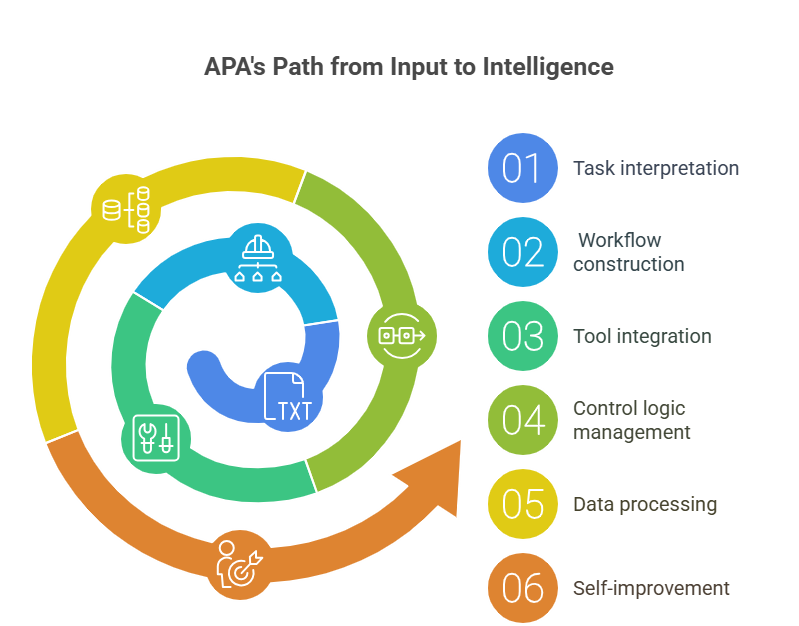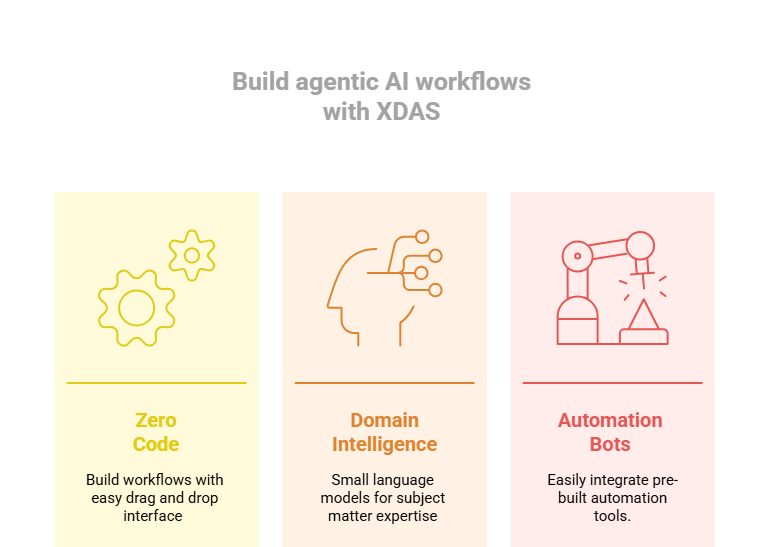You’re busy preparing your client deck, not even blinking an eye. Beep..Beep… your alarm goes off, ‘last call to client meeting’ it says.
You book an Uber cab, hoping for a smoother ride.
Notification: Your ride has been cancelled.
Now you’re a little nervous, afraid you might not make it in time. Time is slipping fast as you’re waiting for another ride.
Another notification: No worries, Uber’s got your back. Your ride is 2 minutes away.
Happy ending.
Let’s not stop with the happy ending like a fairytale. Instead, let’s decode what just happened. Uber didn’t just book you an alternative ride; the system anticipated, acted, and solved the problem faster than ever.
At its core, this illustrates an Autonomous Enterprise in action, a self-sufficient model that many businesses are now striving to achieve.
Wait, What Exactly is an Autonomous Enterprise?
An autonomous enterprise is an organization that leverages AI agents and automation to drive its business operations while minimizing human intervention. These AI agents process data, infer insights, and most importantly, make decisions autonomously to drive better strategic outcomes. This way, there are no bottlenecks; instead, optimized efficiency, productivity, and improved scalability are achieved.
Autonomous enterprises are far more than reactive; they power proactive, self-optimizing systems. To be more clear, earlier AI systems trigger solutions once a problem is identified, whereas autonomous systems anticipate risks and take the best possible actions beforehand, considering the critical factors.
Rethink the Uber situation; their system did not react by saying that your ride is cancelled, instead, it proactively worked to find a solution just in time.
And it is not just Uber,
Google: Employs advanced AI agents to autonomously manage and optimize the cooling of its massive data centers, achieving significant energy savings by proactively adjusting systems without human intervention.
Microsoft: Embeds powerful, task-savvy agents, like those in Microsoft 365 Copilot, directly into everyday workflows, enabling users to autonomously draft content, analyze data, and manage tasks, transforming enterprise productivity.
FourKites: Utilizes intelligent “Digital Workers” to autonomously monitor global supply chains, anticipating disruptions and proactively orchestrating solutions like rerouting shipments to ensure seamless delivery.
Nokia is building autonomous networks for telecommunications, where AI agents intelligently manage and optimize network resources, detect and self-heal issues, and even allocate bandwidth proactively, reducing the need for constant human oversight.
All these businesses are slowly transitioning into autonomous enterprises. But, how is the transformation achieved? The answer is Agentic Process Automation.
The Architecture of Autonomy: Decoding Agentic Process Automation
Agentic Process Automation (APA) is the core framework that powers an end-to-end automation experience by orchestrating AI agents that perform individual tasks. Unlike previous AI models, APA creates a collaborative ecosystem for AI agents to coordinate with one another and deliver informed decisions.
In simple terms, the APA functions much like the human brain. It receives signals from various input sources, interprets and prioritizes them, and coordinates the appropriate responses, ensuring that every part of the system works together seamlessly and stays operational.
What are the core components of agentic AI?

Intelligent orchestration:
Central coordination that manages agent interactions and ensures all agents work towards achieving a single goal, eliminating agent silos.
Context awareness:
This is the most interesting part. Agents don’t work to tick all the checkboxes; instead, they are more outcome-driven. They maintain an understanding of business objectives, current state, and historical patterns, and work towards achieving them.
Adaptive learning:
APA leverages reinforcement learning, a system that continuously learns and executes based on previous outcomes and environment changes. This is like the ideal kind of employee that every company desires: one who is always learning, improving, and never settling.
Multi-modal communication:
You need agents that can follow every language your business uses, whether it’s text, voice, or image. AI agents make this possible seamlessly through their multimodal processing capabilities.
Autonomous decision trees:
Complex reasoning that considers multiple variables and potential outcomes. Think of that strategic advisor in every team, who predicts all possible scenarios, thinks of different decision routes, and then comes up with the best possible decision.
How Agentic Process Automation Works: Behind the Scenes
Let’s walk through the set of processes that fuels every autonomous operation step by step.


Step 1: Task interpretation
The process begins by defining your objectives and desired results for the AI systems. In previous AI systems, this step required technical users to transcribe to the AI agents.
Here’s the good news: you don’t have to speak in coding language, because now agents utilize LLMs that leverage NLP capabilities to understand the user input, even simple business language. Once the goal is accurately captured, the AI agents break down the entire idea into digestible and actionable tasks.
Step 2: Workflow construction
Once the actionable tasks are formulated, the agents autonomously create workflows designed to achieve optimal efficiency. Once complete, the AI agents verify these workflows to ensure they are robust and scalable.
Step 3: Tool integration
Once the workflow is complete, the next step is to bring in the necessary tools to execute it. In previous methods, only tools that are already integrated can be used; however, with APA, agents can integrate any tool or API required for the seamless execution of the workflow.
Step 4: Control logic management
The real magic happens in this step. The AI agents can adapt according to the evolving logic, meaning that whenever there is scope for more efficiency, the agents refine their workflows dynamically.
Step 5: Data processing
The most crucial aspect of AI is that it runs on real-time data. Agents make informed decisions as they process and manage the latest available information.
Step 6: Self-improvement
With AI agents, there is always room for self-improvement. AI agents assess even completed workflows, monitor their performance, and reformulate strategies to derive a more optimized outcome.
The intelligence behind all these processes is Agentic AI, the fuel to agentic process automation.
Agentic AI enables autonomous process automation. According to Gartner, it’s positioned to be 2025’s most transformative technology. NVIDIA’s Jensen Huang predicts that 2025 will be “the year of AI agents.” Mark Zuckerberg is investing heavily in autonomous AI systems.
Forecasts indicate that the market will expand at a CAGR of 35%, ultimately reaching $1.3 trillion by 2030, because agentic AI doesn’t just handle the ‘what’, but also figures out the ‘how’. Here’s what transforms businesses: these three concepts operate as one unified force
How to Get Started with Agentic AI
The whole concept of agentic AI, with its autonomous nature, can be overwhelming. No one is urging you to turn over the keys right this moment.


Start with strategic assessment
The first and foremost step is to conduct an audit to identify potential areas for incorporating agentic AI. Start from low-risk opportunity areas. While ease of implementation is important, it’s equally crucial to balance it with ROI, efficiency, and scalability.
Focus on the sweet spots
Seek out processes that take time, are repetitive, or involve frequent, mundane human labor. They’re perfect candidates for your first-level implementation.
Build trust from a granular level
Establishing the trust factor is crucial while adopting new technologies. With respect to agentic AI, businesses can start with controlled, agentic AI ecosystems, which involve human-in-the-loop approaches at maximum touchpoints. Allow AI to manage the mundane, while people navigate the direction. As you succeed and grow in confidence, you can increase your autonomy.
Embrace the experimental mindset
The most successful autonomous organizations share one common trait: they are not afraid to try new things. They experiment, learn, adapt, and improve. This expansion of mindset is a crucial requirement for making agentic AI possible.
Your Journey to Agentic AI Autonomy
The importance of an autonomous enterprise is undeniable, but the leap from vision to implementation may feel like a bridge too far. Many enterprises become mired in the “how,” how to actually construct agentic workflows without blowing up their current technical infrastructure entirely?
But your journey toward autonomy doesn’t have to start from scratch. With XDAS, you get production-ready agentic workflows right out of the box, so you can start fast, scale smart, and skip the chaos.
XDAS helps you build agentic workflows without the need for coding, using a simple visual interface. Small language models power it with domain-specific intelligence, whether you’re working with ESG data, financial reports, or compliance documents. It also includes ready-made GenAI agents that can be easily adapted to your processes, allowing you to move quickly without reengineering your systems.


The Future Is Autonomous
Here’s what I love most about this shift: it’s not about substituting for humans, it’s about supercharging what makes us distinctively human.
Currently, consider AI agents as highly intelligent interns. They’re excited to work, competent, and can do particular jobs when well-instructed. But in the future? They’re becoming actual AI employees, initiating, strategic, and able to handle entire functions autonomously. And the more AI workers that enter the labor market, the more that organizations inevitably become self-sustaining businesses.
With mundane decisions and repetitive processes left to the machines, you are able to devote yourself to strategy, creativity, networking, and innovation. The technology takes care of execution; the humans create the vision.
Businesses embracing this shift are creating autonomous operations, driven by agentic AI and innovative frameworks. They aren’t just adapting to the future; they’re actively shaping and building it.
Therefore, it’s not a matter of if autonomous businesses will be the future. Change is underway, so are you steering it or just watching it unfold?

